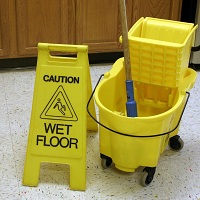Building Operations and Maintenance Services
Follow these sustainable strategies once your renovation and construction projects are complete to help ensure that the building and interior spaces are operated in an environmentally sustainable manner. Operations staff should endeavor to establish and implement best practices in energy efficiency, resource conservation, environmentally preferable products, and other sustainable practices. Federal projects should meet or exceed the Guiding Principles for Sustainable Federal Buildings. Refer to the Apply Section of SFTool for representative project case studies to discover key practices, benefits, results, and checklists. See the Green Procurement Compilation for specific information on sustainable services.
For sustainable strategies specific to non-office workspaces, such as cafeterias and labs, refer to the Explore Section.
Sustainability In Action
Education is the key to changing behavior.
Provide information and training regarding key sustainable strategies of the building and interior spaces and how occupants and operations staff can support the following sustainable efforts:
- Occupant health and wellness (indoor environmental quality)
- Resource conservation (water, energy, materials)
- Waste reduction (recycling)
- Responsible procurement (ecologically sensitive materials/vendors)
- Transportation (mass transit and alternative commuting)
Operations Best Practices
- Establish a green team to promote sustainable practices
- Leverage operational expertise, as well as the scale and diversity of buildings, across building portfolios
- Test promising sustainable technologies in real-life circumstances and implement innovative products, services, and ideas that offer the best value
- Respond quickly to occupants' comfort concerns to help with occupant satisfaction
- Evaluate the impact of operations policies and practices on energy performance
- Provide feedback to occupants on resource use (energy, water, materials) to help achieve sustainability goals
Procurement Best Practices
Indoor Environmental Quality
- Ensure operations staff is conducting preventive maintenance on all building exhaust systems (restrooms, garage exhaust fans, etc).
- Maximize access to daylight and views while avoiding the negative effects of glare
- Ensure occupant comfort
- Enable occupant control of ambient conditions in workspaces through individual or zone control of ventilation and temperature
Energy Performance
Water Management
- Submeter of water systems to identify future opportunities for improvement
- Educate occupants about water efficient fixtures and water saving strategies
- Train to operations staff on proper maintenance of waterless urinals
Waste Reduction and Management
- Communicate facilities guidelines and announcements electronically, versus using printed materials
- Confirm the availability and operational details of recycling and composting infrastructure and institute a program to recycle materials
- Host recycling and composting workshops to educate occupants about what can be recycled and composted and how materials are collected
- Provide well labeled and easily accessible containers for the collection and storage of recyclable and compostable materials; make recycling and composting the default option
- Divert construction waste from landfills and facilitate the recycling of construction waste through the standardization of processes
Custodial Services
- Ensure that a Healthy Cleaning Plan, based on a list of healthy cleaning needs, including areas to be cleaned and levels of service, is being implemented, as well as monitored and audited for quality assurance
- Ensure that an Exposure Control Plan is being implemented
- Use cleaners certified to a sustainability standard or ecolabel (e.g., BioPreferred or Safer Choice)
- Follow GSA's Integrated Pest Management Guidance and use the Green Procurement Compilation (GPC) for guidance on procuring IPM services
- Ensure that a Hazard Communication Plan and Pandemic Plan have been developed
References/Resources
- Acquisition.gov | Federal Acquisition Regulation (FAR) Part 23 - Environment, Energy, and Water Efficiency, Renewable Energy Technologies, Occupational Safety, and Drug-Free Workplace

- Acquisition.gov | Federal Acquisition Regulation (FAR) Part 52 - Solicitation Provisions and Contract Clauses, Subpart 223

- LEED Building Operations & Maintenance (O+M) Rating System
 and LEED Reference Guide for Building Operations and Maintenance
and LEED Reference Guide for Building Operations and Maintenance
Related Topics
Cleanliness
Building cleanliness is both the process of removing dirt and contaminates from the building as well as the process of maintaining this state. Keeping the facility clean decreases the occurrence of “sick building syndrome” and uses less toxic chemicals in the process. Occupants are also more likely to express satisfaction and lose less productivity due to absenteeism in a well-cleaned building.
Construction and Demolition Waste
Unlike operational waste, which is made after a building is built, construction waste refers to materials and debris generated during construction, renovation, demolition, or dismantling of structures, buildings and associated infrastructure. Material types in operational and construction waste differ from operational waste, so reduction and diversion strategies also differ. See Whole Building Design Guide | Construction Waste Management![]() .
.
Custodial
Eco-Team
Groups of occupants/tenants and building staff who voluntarily educate fellow occupants and empower their organization to adopt sustainable practices. Identifying and implementing building-specific initiatives through occupant-run programs and regularly occurring calendar events, these teams seek to create a more environmentally friendly workplace.Energy Efficiency
Energy efficiency is a comparison of the amount of energy used compared to the amount of output produced. In the built environment, this means using the least amount of energy (electricity, natural gas, etc.) to operate a facility appropriately. Steps that can help a building run efficiently include: ensuring there are no air leaks, using sensors or timers to ensure the building isn’t operating when vacant, and using energy-efficient equipment.
Federal Requirements
Federal requirements are important considerations when starting any sustainable project. Within SFTool, these include the Guiding Principles, Executive Orders, and other guidance or regulatory documents.
Federal requirements are viewable when exploring Sustainable Workspaces and Whole Building Systems.
Green Cleaning
Cleaning removes pathogens, dirt, and impurities from surfaces or objects. Cleaning works by using soap (or detergent) and water to physically remove pathogens from surfaces. This process does not necessarily kill pathogens, but by removing them, it lowers their numbers and the risk of spreading infection.
Healthy, or sustainable, cleaning refers to processes and procedures that minimize harmful effects to the occupants of the built environment while also being able to use the cleaning tools and products for an indefinite time frame. The goal is to negate negative effects on the built environment and its occupants.
Visit SFTool's Healthy Cleaning page to learn more.
Heating, Ventilating and Air Conditioning (HVAC)
Heating, ventilation, and air conditioning systems are designed to work together to maintain occupant comfort. From residential to commercial settings, HVAC systems help to keep people comfortable and healthy by maintaining good indoor air quality and comfortable temperatures.
Whole Building Design Guide | High-Performance HVAC![]()
Indoor Air Quality (IAQ)
Indoor Air Quality (IAQ) refers to the state of the air within a space. A space with good indoor air quality is one that is low in toxins, contaminants and odors. Good air quality possible when spaces are well ventilated (with outside air) and protected from pollutants brought into the space or by pollutants off-gassed within the space. Strategies used to create good IAQ include bringing in 100% outside air, maintaining appropriate exhaust systems, complying with ASHRAE Standard 62.1, utilizing high efficiency MERV filters in the heating ventilation and air conditioning (HVAC) system, installing walk-off mats at entryways, prohibiting smoking with the space and near operable windows and air intakes, providing indoor plants, and using only low-emitting / non-toxic materials and green housekeeping products.
Integrated Pest Management (IPM)
Integrated Pest Management is is a process used to reduce or discourage the growth of pest populations. IPM protects human health and the surrounding environment and improves economic returns by employing the most effective, least-risk management option. It uses non-toxic products such as cleaning and physical barriers to entrance before resorting to chemical means. Pests include plants, fungi, insects, and/or animals.
http://www.sfenvironment.org/about![]()
Occupant Comfort
Workspaces should be designed and operated to support the functional and environmental needs of occupants. Design for thermal comfort should be based on ASHRAE Standard 55. Design for air quality should be based on ASHRAE 62. Occupant comfort should be assessed frequently once a building is occupied, using ASHRAE’s Performance Measurement Protocols for Commercial Buildings.
ASHRAE.org | Standards 62.1 and 62.2![]()
Occupant Engagement
Occupant engagement involves communicating with, enabling and empowering building occupants to help meet sustainability goals for the building. This can involve providing information on actions occupants can take to improve building performance and resource efficiency, while making it easy and appealing for occupants to do so (e.g. actions that improve productivity).
Occupant Satisfaction
A primary goal of sustainable design is to maximize occupant comforst and satisfaction, while minimizing environmental impact and costs. Comforst and satisfaction are important for many reasons, not least of which is that they correlate positively with personal and team performance. The greater the satisfaction, the higher the productivity and creativity of an organization. It has also been demonstrated that occupant satisfaction impacts staff rentention.
Occupant Sensor/Automatic Lighting Control
Occupant sensors and automatic lighting controls can save energy by turning lights off when occupants are not present or when enough daylight is present to light the space. These controls can also help occupants take advantage of the benefits of natural light.
Outside Air
Outside air is fresh air that comes into the facility as supply air. It is mixed with air already conditioned in the space.
Recycled Content
Products containing recycled content are made from materials that would otherwise be discarded. Recycled content material reduces the need for virgin materials. There are two types of recycled content: post-consumer and pre-consumer (also called post-industrial).
Whole Building Design Guide | Evaluating and Selecting Green Products![]()
Recycling
Recycling is the process of collecting and processing materials (that would otherwise be thrown away as trash) and remanufacturing them into new products. Recycling support stations and the education of occupants and janitorial staff are the backbone of a successful waste diversion plan. Start by confirming with the recycling hauler and compost service what materials are acceptable and the proper collection method. Separate, color-coded, well-labeled and strategically placed recycling containers and waste receptacles make sorting and collection convenient and support occupant participation.
Solid Waste
Waste comprises all materials that flow from a building to final disposal. Examples include paper, grass trimmings, food scraps, and plastics. Responsible stewardship tries to divert as much waste as possible from the landfill. This can mean recycling paper, mulching or composting grass trimmings, and reusing large items, such as furniture.
EPA | Land, Waste, and Cleanup Topics![]()
Submetering
Submetering or system-level metering is used to determine the proportion of energy use within a building attributable to specific end uses or subsystems (e.g., the ventilation system of an HVAC system). This energy use information can be used to support energy management and identify opportunities for additional energy saving improvements.
See U.S. Department of Energy guidance for Federal Agencies.![]()
Water Conservation
Over 400 billion gallons of water are used every day in the United States. Demand is increasing even though usable supply is decreasing. Civilian agencies in the federal government use 47 billion gallons of water per year, the equivalent of more than 70,000 Olympic-size swimming pools. These agencies could save 7.8–12.3 billion gallons (17–26%) annually just by using simple “off the shelf” water conservation measures, including replacing existing toilets, faucets, and showerheads with more efficient versions.
GSA | Indoor Water Conservation![]()
DOE | Developing a Water Management Plan![]()
DOE | Guidance for the Implementation and Follow-up of Identified Energy and Water Efficiency![]()


